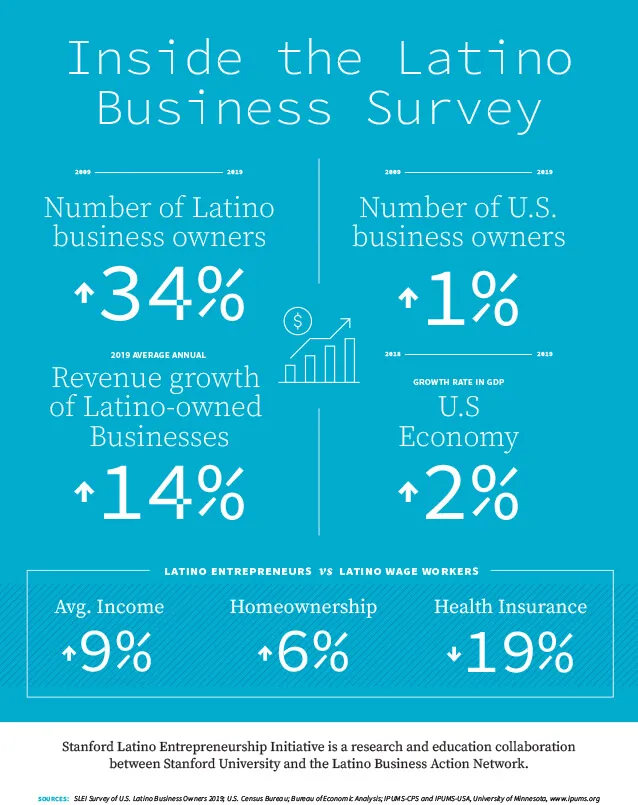How Latino Entrepreneurs Can Boost the U.S. Economy
Latinos are launching businesses at an unprecedented pace, but barriers — some long-standing, some brand new — keep them from reaching their potential.
January 31, 2020

“Latino-owned businesses are a real asset to the U.S. economy,” says Jerry I. Porras. “What you do with assets is invest in them. You promote them. You support them.” | Erika Rodriguez
The number of Latino business owners has surged by 34 percent over the past decade, outpacing that of any other ethnic group. Yet despite that entrepreneurial vigor, Latino business owners face ongoing challenges, as their companies tend to remain smaller and less profitable than white-owned businesses.
And while Latino entrepreneurs fare better than the general Latino population when it comes to average income and homeownership rates, they still experience significant gaps relative to other groups in their rates of home ownership, health insurance coverage, and income.
To help academic researchers, lending institutions, business leaders, and policymakers understand and improve this dynamic, the Stanford Latino Entrepreneurship Initiative, a research and education collaboration between Stanford University and the Latino Business Action Network housed at Stanford Graduate School of Business, has been collecting extensive and detailed data on the Latino business experience. Its fifth annual State of Latino Entrepreneurship report compiles data from their survey of over 5,000 Latino-owned businesses across the U.S. and Puerto Rico, and a range of other sources, including the U.S. Census Bureau, to examine national trends underlying Latino business growth.
The latest SOLE report was overseen by two Stanford GSB faculty members: Paul Oyer, the Mary and Rankine Van Anda Entrepreneurial Professor and Professor of Economics, and Jerry I. Porras, the Lane Professor of Organizational Behavior and Change, Emeritus.
Here, they discuss the Latino business community’s struggle to access capital, and why that effort’s success — or failure — will dramatically impact the U.S. economy.
Your report shows that Latinos are overrepresented when it comes to starting their own businesses. Why is that?
Paul Oyer: The fraction of people who are entrepreneurs is growing among Latinos and not growing among other groups, and there’s a lot of speculation about that. Some of it may be that they’re just catching up, that their rates were low to begin with, and some may be that Latinos have less opportunity in the more standard labor market.
Jerry I. Porras: Latinos as a culture gravitate toward starting businesses and being their own boss, creating something for their families. Another important ingredient is that a lot of Latino businesses are being started by immigrants, who are hungrier and more passionate about what they’re doing and want to have an impact on their own financial well-being. Being an entrepreneur is a powerful way to do that. A third component is that Latinos who aspire to be highly successful find it extremely difficult to do so in the normal corporate environment. The reality is that the number of Latinos at top levels like CEOs at Fortune 500 companies is extremely small and hasn’t grown much over the last 10 years. So entrepreneurship is seen as a positive alternative — if you can start your own company and grow it big, you can be the CEO of a big company, whereas you might never achieve that same level if you’d gone into the corporate world.
Your data shows that Latino-owned businesses experience funding shortfalls from traditional small business lending sources — such as local banks — more frequently than other groups. Is this evidence of implicit bias?
Porras: I don’t think we can make the statement that it’s an implicit bias. But we need more information about what criteria are used to make loans. To be really thorough, you’d have to find out if the same criteria are being applied to two sets of businesses, one being Latino and the other not. What is the rate of loans and the size of loans given to those two groups? That would be challenging research to do, and it hasn’t been done. But it appears that’s where the barrier is.
How can this funding barrier be overcome?
Porras: The clearest answer is that business owners should shop around. As soon as banks start competing to get loans, things start to change. So getting multiple offers is a good idea. A second approach is to press the bank on what criteria it’s using to deny the loan, or what criteria isn’t being met. Then the business owner can understand what they’re missing and fix it, so the next time around that issue can’t be used to deny the loan.
What responsibility do banks have in regard to removing these barriers?
Porras: In the long term, this is an educational process, in which all sorts of financial institutions need to begin to shift their framing of the risk involved with Latino-owned businesses — understanding that it’s not any more risky than a non-Latino business and that, in fact, there may well be advantages to doing business with Latinos. It’s going to happen through the success of Latino businesses and proving that they are lower-risk, they can be successful, and they can return whatever investment is made in them.
What happens when Latino business owners have to resort to funding from sources such as personal credit cards and home equity loans?
Oyer: If businesses have to borrow through suboptimal means, they’ll often forgo growth opportunities or not find them as profitable as they would otherwise be. Both of these issues can constrain growth.
Porras: Aside from the fact that these sources are much more expensive for the business than traditional ones, the biggest consequence of using home equity or personal credit cards is that the business owner is bearing much more personal risk. If the funding is repaid, then the risk is eliminated, but the personal stress that must be borne until the funding is repaid is a cost that can’t be easily quantified. And if the funding can’t be repaid, the owner loses a substantial portion of their personal assets.
Latino-owned businesses often fail to take advantage of lucrative corporate and government contracts. How can this be improved?
Porras: Perhaps the biggest barrier is certification. Most Latino-owned businesses aren’t certified by the proper agencies or organizations and, as a result, don’t qualify for government or corporate contracts. A second factor is lack of knowledge. The Latino business owner isn’t in the proper networks and just isn’t aware of the possibilities these contracts offer. Another factor is the aversion to all the paperwork it takes to secure these contracts, especially government ones.
Overcoming these barriers would require more proactive efforts by the government and business entities to educate and assist Latino-owned businesses in getting themselves qualified and in overcoming the paperwork barrier. Nonprofits could also play a role in providing the needed information and education.
The Tax Cuts and Jobs Act of 2017 created “opportunity zones” as a way to encourage economic development and job creation in low-income communities, but the majority of Latino business owners you surveyed didn’t know what these zones were or whether they were located in one. Why is that?
Oyer: This is a really interesting finding. I think the history of opportunity zones and the positive effects they were expected to have isn’t that great. And many of the people they were expected to directly benefit are just too busy trying to make payroll to know what to do about it.
Porras: Also, the government, which is supposed to be pushing these opportunity zones, is not being proactive about reaching out and informing people about the various programs the opportunity zones provide. They haven’t been fulfilling the promise, because such a large number of Latino business owners don’t even know about opportunity zones. That seems utterly ridiculous in this environment.
What will be the impact on the U.S. economy if Latino business owners remain unable to access needed capital and scale their businesses?
Porras: Latinos are going to be one-third of the population in the future. And if the Latino portion of the economy isn’t more developed economically — if Latinos are basically at a subsistence level and not at a stronger level equal to everyone else — the whole economy will suffer, because the economy is driven primarily by consumption. That’s the long-term perspective, which is rooted in a 30-year horizon.
Your data shows that if the current number of Latino-owned businesses were to grow to match the size of their non-Latino counterparts, it would add 5.3 million new jobs and $1.5 trillion to the U.S. economy.
Porras: And that’s if we took the average revenue of Latino-owned business and raised it just to the average revenue of the non-Latino-owned business — not above, but just to the average. The difference to the economy would be those numbers.
How does that begin to happen?
Porras: Latino-owned businesses are a real asset to the U.S. economy. As a country, we’ve got to start treating them as an asset and not as unimportant — or as a liability. What you do with assets is invest in them. You promote them. You support them. You want to make them stronger and more effective. Viewing Latino business as an asset and helping them reach their potential makes it much, much more likely that the economy will benefit over the long term.

For media inquiries, visit the Newsroom.
Explore More

When Is It Too Late to Give Up Control of Your Finances?

Recessions Are Painful, but Stagnant Growth Could Prove More Challenging



